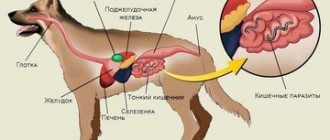Viral hepatitis in dogs (canine adenovirus, fulminant liver failure)
– a serious contagious viral disease characterized by fever, catarrhal inflammation of the gastrointestinal tract, mucous membranes of the respiratory system, central nervous system, follicular conjunctivitis, and the development of destructive and degenerative processes in the liver. Dogs of all age groups and breeds are susceptible to hepatitis. Small puppies aged 1.5 to 3 months are most susceptible. In dogs over three years of age, viral hepatitis is diagnosed extremely rarely. Infectious hepatitis occurs in isolated cases and epizootic outbreaks.
Etiology of hepatitis in dogs
Viral hepatitis is caused by a DNA-containing adenovirus type CAV I 9 (Adenovirus caninae). All types of strains have almost the same low virulence. The causative agent of hepatitis is similar to the infectious laryngotracheitis virus. The hepatitis virus is resistant to high and low temperatures, ether, some acids, methanol, and chloroform.
Initially, the virus is localized in the endothelial cells of the larynx, pharynx, esophagus, and tonsils. Further reproduction of the virus occurs in the cellular structures of various internal organs, regional (submandibular, retropharyngeal) lymph nodes.
The greatest localization of the virus is noted in the cellular structures of the liver. Under the influence of exotoxins in tissues, the development of pathological inflammatory, degenerative, necrotic processes is observed, leading to disruption of the functioning of the liver, central nervous system and gastrointestinal tract, and destruction of renal vessels. Multiple foci of inflammation, hemorrhages, and perivascular edema occur. Toxins and poisons secreted by the adenovirus have a destructive effect on the vascular endothelium. Their insight increases.
In nature, wild animals are the reservoir of the virus. Infection occurs through contact of infected animals with healthy individuals. Virus carriers and animals that have recovered from hepatitis release adenoviruses into the external environment through urine, feces, conjunctival secretions, and nasal discharge.
Infection with hepatitis occurs through nutritional means, through the consumption of water and feed contaminated with the virus. The risk group includes weakened animals with a decrease in the body's resistance, as well as dogs kept in kennels under unfavorable conditions. Infection can occur through equipment, ammunition, bedding that was used to care for sick or recovered animals, special clothing, and hygiene items.
The development of hepatitis is facilitated by unfavorable living conditions, poor-quality, unbalanced diet, hypothermia, insufficient concentration of vitamins and minerals in the feed, and the presence of concomitant pathologies and diseases.
Epizootology: under what conditions the virus is most dangerous
Rubart's disease is dangerous for pets, as well as for all members of the canine family - wolves, jackals, foxes and arctic foxes. The virus is more dangerous for unvaccinated puppies 1.5-12 months old. After 3 years, the disease is registered much less frequently or occurs in a milder form.
It is noteworthy that humans, rodents and cats can become hidden sources of the disease, that is, not only sick dogs are a reservoir for infection. The virus is released into the external environment from sick dogs or virus carriers with saliva, mucus from the sinuses, discharge from the eyes, feces and urine. This process can take up to several months, which means the pet is potentially dangerous for healthy individuals.
Viral hepatitis can occur in the form of one-time episodes when the dog is kept alone. But in nurseries, with crowded housing or in a pack of stray dogs, the intensity of infection can increase to 75-80% with a mortality rate of up to 30-35%. This means that out of 10 individuals, 3-4 dogs die.
In nurseries, the virus spreads quickly through feed, water, and common bedding. It is transferred from cells to cells on the clothes of service personnel, through equipment when cleaning feces.
The speed of spread and susceptibility to the virus directly depends on the resistance of the dog’s body. Factors provocateurs:
- systematic hypothermia;
- overheating;
- low-quality feed;
- minimum vitamins and minerals.
Concomitant diseases or infectious pathologies (plague, streptococcosis, toxoplasmosis, etc.) increase the risk of infection with infectious hepatitis and in almost 99% of cases lead to death. Therefore, in order to protect your dog from accidents, you need to carefully monitor your pet’s health from puppyhood.
Symptoms of viral hepatitis in dogs
From the moment of infection until the first symptoms of hepatitis appear, it can take five to ten days. The disease occurs in fulminant, acute, subacute, latent (latent) forms. A more distinct clinical picture is observed in young animals up to one year old.
In the acute form, dogs are diagnosed with:
- temperature increase;
- general depression, decreased physical activity;
- gastroenteritis;
- profuse diarrhea;
- yellowness of the mucous membranes and whites of the eyes;
- frequent urge to urinate, dark urine;
- attacks of nausea, vomiting;
- weight loss;
- enlargement, hemorrhage of lymph nodes;
- disturbance of electrolyte metabolism and metabolic processes;
- blood clots and mucus are noted in the stool;
- unilateral, bilateral keratitis;
- enlarged, painful lymph nodes, tonsillitis.
When palpating the dog's abdominal cavity, pain and discomfort are noted, especially in the liver area. Due to pain, dogs often sit in an unusual position, with their forelimbs spread wide apart. Animals may have difficulty breathing, shortness of breath, and possible problems in the functioning of the central nervous system and cardiovascular system, namely: rapid pulse, arrhythmia. Due to long-term disruption of albumin synthesis in the liver, hypoproteinemic edema (ascites) is noted in the peritoneal area.
As hepatitis progresses, dogs experience severe itching, which leads to scratching on the body. Mucous, unpainted areas of the skin become jaundiced. Puppies may have seizures, muscle spasms, limb weakness, and lack of coordination. Spontaneous abortions and the birth of weak, non-viable offspring are possible in pregnant bitches.
The manifestation of clinical signs depends on the form and stage of hepatitis. In subacute, chronic cases, the clinical picture is less pronounced. The chronic form is diagnosed in adult dogs. Disturbances in the functioning of the digestive system, diarrhea, periodic fever, anemia of the mucous membranes, swelling of the subcutaneous tissue, enlargement, and hemorrhage of the lymph nodes are noted.
The latent form occurs without obvious, characteristic signs. There may be a deterioration in appetite, a slight increase in temperature, attacks of vomiting, and dyspepsia. Various unfavorable factors contribute to the manifestation of symptoms. In acute, hyperacute hepatitis, mortality in puppies is 90-100%.
Possible complications include: acute liver failure, glaucoma, pyelonephritis.
General information about canine hepatitis
Hepatitis in dogs, like in humans, is associated with the entry into the body of the adenovirus CA VI, which spreads with lightning speed through living tissues and cells, affecting almost all organs. But the heaviest blow falls on the liver: this organ begins to become seriously inflamed and then necrotic under the influence of this virus. Accordingly, the disease itself is not as terrible as its consequences.
The liver, suffering from degenerative changes, begins to break down and ceases to perform its functions. The dog begins to suffer from intoxication of the body, and in advanced cases it may die from a malfunction of the nervous system, from kidney failure or hepatic coma. In addition, hepatitis provokes bleeding in the gastrointestinal tract, which can also be fatal for the pet.
Dog liver infected with adenovirus
The term "hepatitis" stands for inflammation of the liver. Like any inflammatory process, hepatitis is characterized by a massive, strong blood flow to the organ, which severely impairs its functioning. Depending on the type of illness, the animal will experience additional problems.
Types and forms of hepatitis in dogs
Hepatitis in dogs has two forms. The worst is fulminant, when the virus instantly spreads throughout the body within a few hours. The owner may not even have time to come home from work or react to the lethargy of the pet before death occurs. The second form of hepatitis is chronic, treatable, and the complexity of therapy and the duration of the recovery period depend on the age and general health of the animal, as well as the severity and type of the disease itself.
The most dangerous is the fulminant form of hepatitis.
Table. Types of canine hepatitis
| Infectious | Toxic |
| The most common illness caused by adenovirus entering the body. The disease can strike an animal at any age, but puppies and young dogs are more often affected. | This type of hepatitis is caused by the accumulation of toxins in the liver, most often the disease is associated with long-term use of medications, poisoning or poor-quality diet |
Dogs of any age can get hepatitis.
Diagnosis of hepatitis in dogs
Given the similarity of symptoms with other infectious diseases, for example, parvovirus enteritis, toxoplasmosis, canine distemper, leptospirosis, differential diagnosis is mandatory. Also in veterinary clinics, abdominal radiography, ultrasound of the peritoneal organs are prescribed, biochemical, bacteriological, serological blood tests, test analyzes (RIF, RN) are carried out. Based on the results of diagnostic studies, veterinary specialists prescribe appropriate treatment.
Infectious hepatitis: brief description
The disease is highly contagious, meaning it is dangerous to almost all carnivores and spreads quickly. There are no pronounced age or breed gradations; the virus is equally dangerous for puppies of “nobles” and for giant dogs of elite lines. At risk are weakened animals, infected with helminths, lacking sufficient nutrition, and kept in inappropriate conditions.
Important! A DNA virus in an acute form is especially dangerous. Specialists of the RosVet VC warn that if you do not go to a veterinary clinic in a timely manner and if there is no treatment in the first days after infection or the appearance of symptoms, death cannot be ruled out.
Treatment of hepatitis in dogs
Complex treatment includes the use of symptomatic, antihistamine, antiviral drugs, broad-spectrum antibiotics of the cephalosporin and penicillin series (ampiox, caricef, fortum, ampicillin). Dogs are prescribed symptomatic, pathogenetic, etiotropic therapy, antiviral chemotherapy, and specific immunotherapy.
To normalize liver function, dogs are additionally prescribed decoctions and tinctures based on medicinal herbs - decoctions of chamomile, St. John's wort, coltsfoot, bearberry, yarrow, string, and hepatoprotectors are prescribed.
Animals are prescribed specific immunotherapy through the use of hyperimmune sera. To normalize the microflora, dogs are given medications containing lactobacilli and given cleansing and nutritional enemas.
To eliminate pain symptoms, analgesics and sedative medications are prescribed. To strengthen and activate the defenses, dogs are prescribed vitamin-mineral complex preparations, ascorbic acid, group B preparations. Vitamin preparations are administered intramuscularly, subcutaneously. Among the multivitamins prescribed are Undevit, Hexavit, Nutrisan, Revit.
To eliminate signs of intoxication, animals are injected intravenously with physiological solutions - Ringer's solution, Ringer-Locke solution, Trisol, isotonic sodium chlorine, and other antitoxic drugs. During treatment, dogs are prescribed a therapeutic diet. Fatty foods are excluded from the diet. If possible, dogs are prescribed nutritional feeding.
When keeping dogs in kennels, recovered animals are placed in an isolated enclosure, and the premises, equipment, and household items are disinfected.
Prevention of hepatitis in dogs
The main prevention lies in timely vaccination. Puppies can be vaccinated from 6-8 weeks. Mono- or polyvaccines are used. Repeated vaccination is carried out when the dog turns one year old. They pay attention to the diet, monitor the dog’s condition, carry out sanitary and hygienic measures in a timely manner, and adhere to the vaccination schedule established by the veterinarian. If the first, even minor symptoms appear, you should immediately show the dog to a veterinarian.











